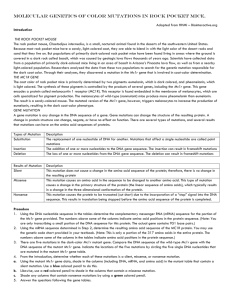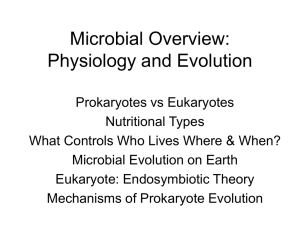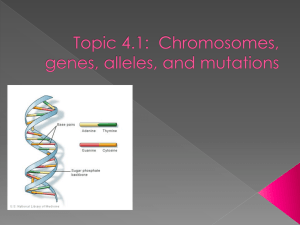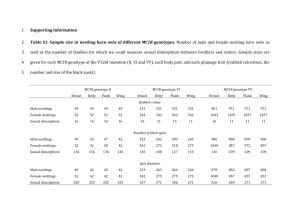File
advertisement
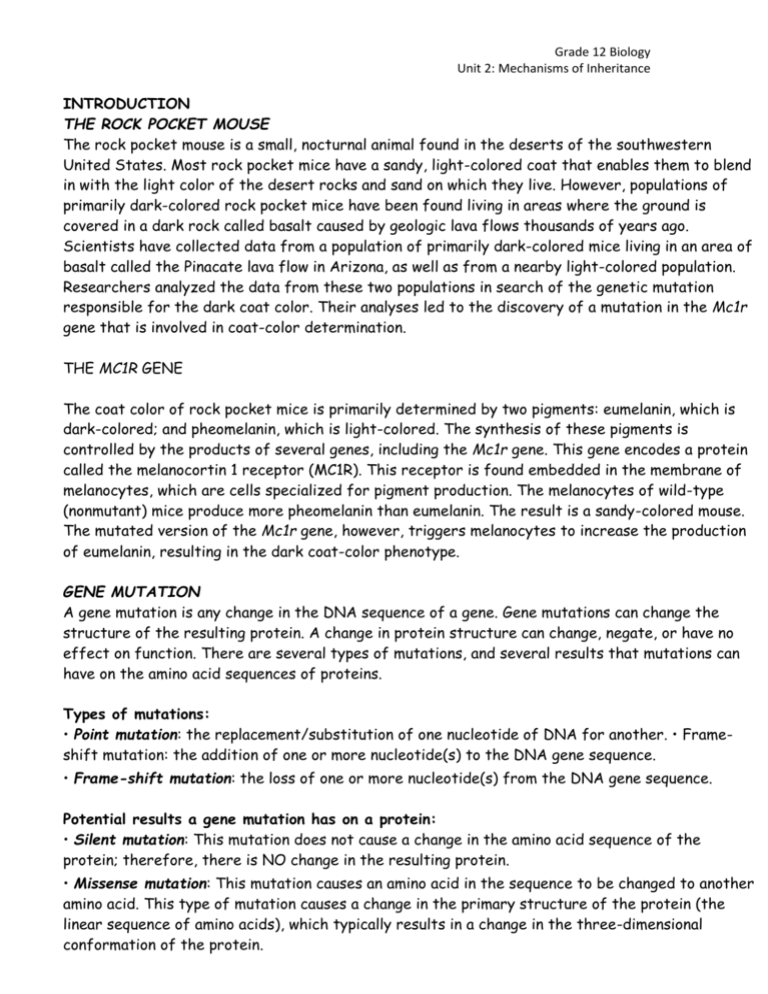
Grade 12 Biology Unit 2: Mechanisms of Inheritance INTRODUCTION THE ROCK POCKET MOUSE The rock pocket mouse is a small, nocturnal animal found in the deserts of the southwestern United States. Most rock pocket mice have a sandy, light-colored coat that enables them to blend in with the light color of the desert rocks and sand on which they live. However, populations of primarily dark-colored rock pocket mice have been found living in areas where the ground is covered in a dark rock called basalt caused by geologic lava flows thousands of years ago. Scientists have collected data from a population of primarily dark-colored mice living in an area of basalt called the Pinacate lava flow in Arizona, as well as from a nearby light-colored population. Researchers analyzed the data from these two populations in search of the genetic mutation responsible for the dark coat color. Their analyses led to the discovery of a mutation in the Mc1r gene that is involved in coat-color determination. THE MC1R GENE The coat color of rock pocket mice is primarily determined by two pigments: eumelanin, which is dark-colored; and pheomelanin, which is light-colored. The synthesis of these pigments is controlled by the products of several genes, including the Mc1r gene. This gene encodes a protein called the melanocortin 1 receptor (MC1R). This receptor is found embedded in the membrane of melanocytes, which are cells specialized for pigment production. The melanocytes of wild-type (nonmutant) mice produce more pheomelanin than eumelanin. The result is a sandy-colored mouse. The mutated version of the Mc1r gene, however, triggers melanocytes to increase the production of eumelanin, resulting in the dark coat-color phenotype. GENE MUTATION A gene mutation is any change in the DNA sequence of a gene. Gene mutations can change the structure of the resulting protein. A change in protein structure can change, negate, or have no effect on function. There are several types of mutations, and several results that mutations can have on the amino acid sequences of proteins. Types of mutations: • Point mutation: the replacement/substitution of one nucleotide of DNA for another. • Frameshift mutation: the addition of one or more nucleotide(s) to the DNA gene sequence. • Frame-shift mutation: the loss of one or more nucleotide(s) from the DNA gene sequence. Potential results a gene mutation has on a protein: • Silent mutation: This mutation does not cause a change in the amino acid sequence of the protein; therefore, there is NO change in the resulting protein. • Missense mutation: This mutation causes an amino acid in the sequence to be changed to another amino acid. This type of mutation causes a change in the primary structure of the protein (the linear sequence of amino acids), which typically results in a change in the three-dimensional conformation of the protein. Grade 12 Biology Unit 2: Mechanisms of Inheritance • Nonsense mutation: This mutation causes the protein to be cut short due to the incorporation of a “stop” signal into the DNA sequence. This results in translation being stopped before the amino acid sequence of the protein is completed. Procedure 1. Using the DNA nucleotide sequence in the gene tables for the wild-type light coat color phenotype, determine the complementary mRNA sequence for the portion of the Mc1r gene provided. The actual gene contains 951 base pairs. 2. Using the mRNA sequence determined in Step 1, determine the resulting amino acid sequence of the Mc1r protein using your amino acid codon table. 3. Repeat Step 1 and 2 for the gene tables for the mutant Mc1r gene dark coat color phenotype. 4. There are five gene mutations in the dark-color Mc1r mutant gene. Compare the DNA sequence of the wild-type Mc1r gene with the DNA sequence of the mutant Mc1r gene. Indicate the locations of the five mutations by circling the five single DNA nucleotides that are mutated in the mutant Mc1r gene table. 5. Determine whether each of these mutations is silent, missense, or nonsense mutation. a. Shade in the DNA, mRNA and amino acid boxes that contain a silent mutation with a BLUE colored pencil. b. Shade in the DNA, mRNA and amino acid boxes that contain a missense mutation with a RED colored pencil. c. Shade in the DNA, mRNA and amino acid boxes that contain a non-sense mutation with a GREEN colored pencil. 6. Answer the questions following the gene tables. Grade 12 Biology Unit 2: Mechanisms of Inheritance GENE TABLE LIGHT COLORED COAT PHENOTYPE (NORMAL MC1R GENE) Grade 12 Biology Unit 2: Mechanisms of Inheritance GENE TABLE DARK COLORED COAT PHENOTYPE (MUTATED MC1R GENE) Grade 12 Biology Unit 2: Mechanisms of Inheritance QUESTIONS 1. Of the five mutations you identified in the Mc1r gene, how many are: _______ substitutions ______ insertions ______ deletions 2. Of the five mutations you identified in the Mc1r gene, how many are: _______ silent ______ missense _______nonsense 3. Explain the link between DNA sequence and protein structure and function. 4. Using the background information on mutations and your knowledge of proteins, explain how the changes in the MC1R protein’s amino acid sequence might affect its function.





